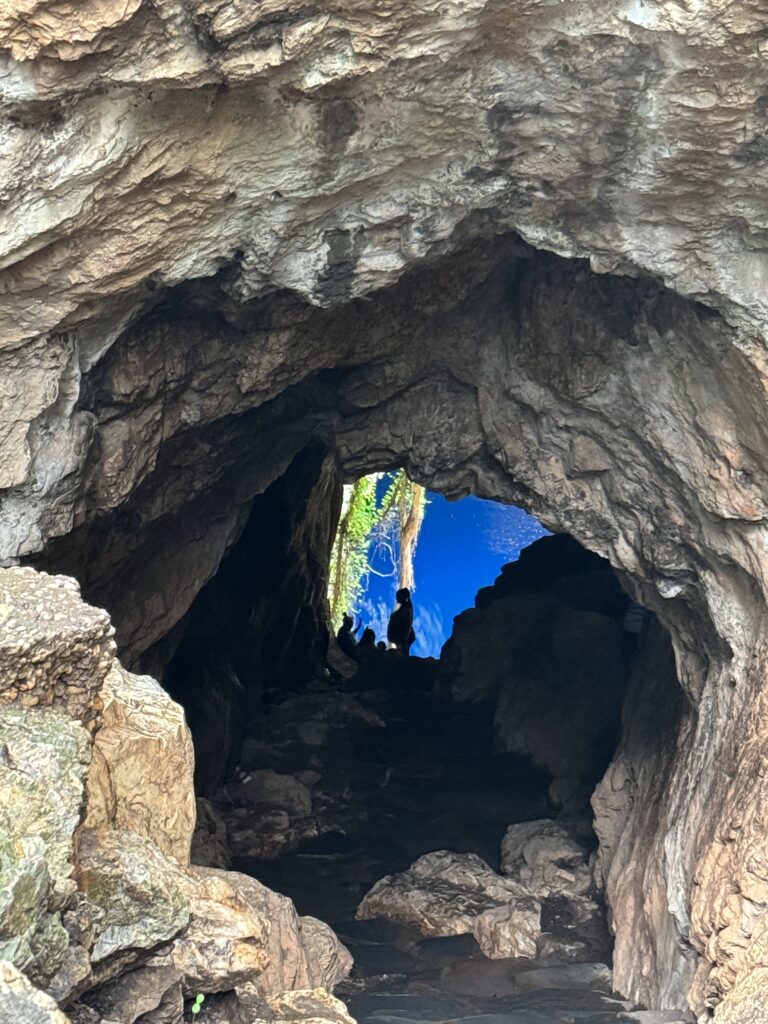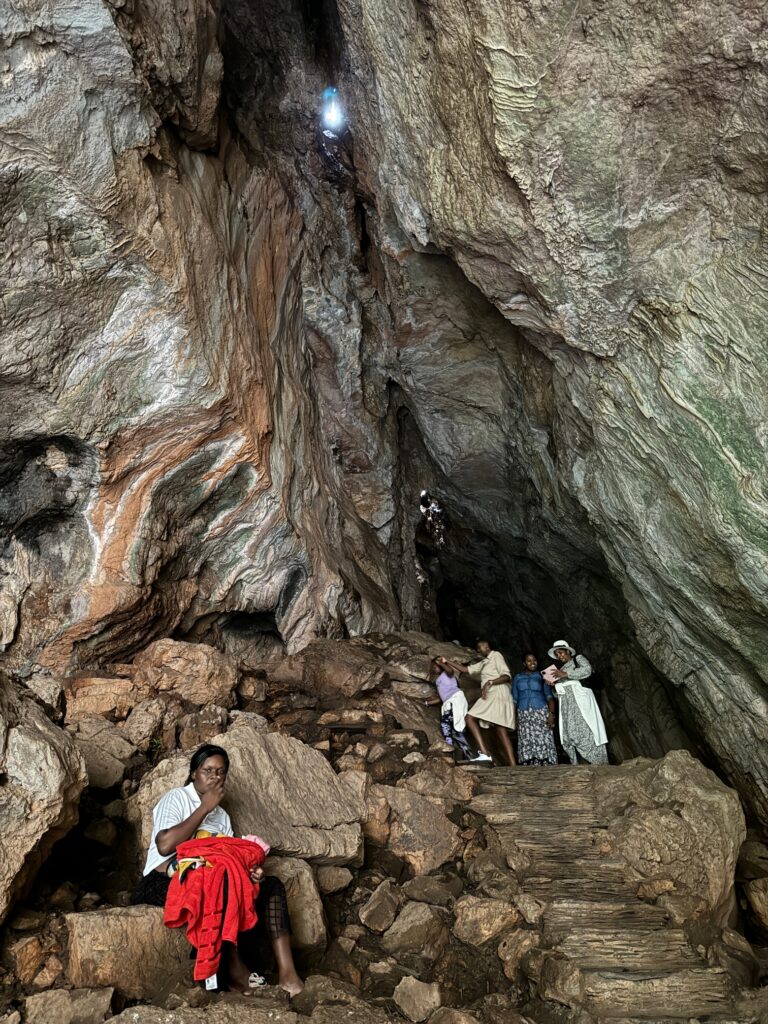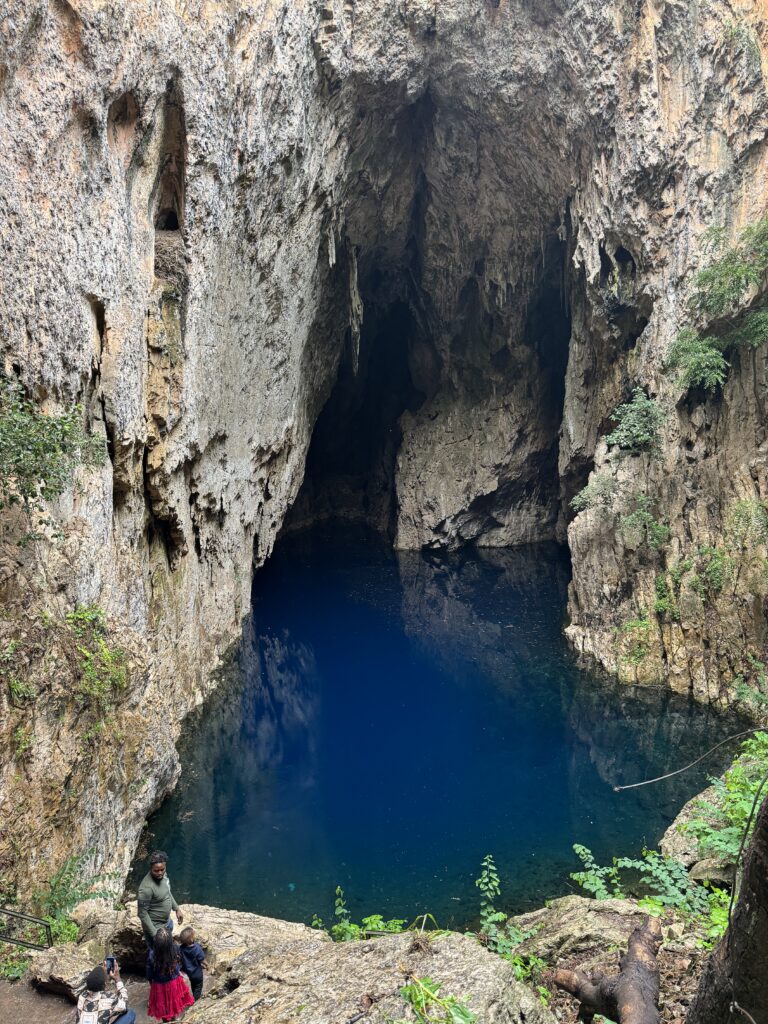By: Chipo Mapondera
Kuchema
A Place to Cry
ABSTRACT

The Shona word for grieving is “kuchema”, which also means “to cry”. In the time around grief, there are a number of ceremonies and practices carried out, in service of sending off the deceased with dignity, and holding space for those left behind, to cry. In the community during this time, wailing, ululating, singing and drumming are heard, as part of the healing process.
This project presents a virtual reality healing space, exploring Shona traditional values. It is a site where users can enter, to find solace through sound, space and communal ceremony. The concept is based on a hypothesis that people are struggling with IRL reality imposed by the systems of colonialism, patriarchy and capitalism. This is exacerbated by technology, which impacts users’ emotional and mental well-being. By developing this VR experience, I seek to hack these systems. Furthermore, traditional gaming theory was influenced by Cold War/ Neoliberal ideologies of instant gratification and winning. In my work, I disrupt these values by designing spaces that explore new realities and foster community.
Finally, the work will hack history by presenting an imagined reality of how Zimbabwean society and contemporary culture might have developed, had it not been disrupted by European colonialism. This is done by exploring the rich culture, values and spiritual modalities of our traditions. The project questions how we would implement our traditional healing modalities for modern life, and how our natural spaces would be used. The visitor is cocooned by mist and I’mspiritual beings, and held by a physical and metaphysical community (in the virtual).
Discover the Kuchema Prototype on Spatial. Create and account on Spatial.io and link to the URL, on your computer.
To view on a VR headset, mobile phone or tablet, download the Spatial app, access your account, and search for Kuchema Prototype.
Collaborators:
3D modellling: Joel Chandauka
Soundscape Design: Fungai Nengare
KUCHEMA: THE SOUNDSCAPE
The spirituality of water carries great significance across Zimbabwean cultures. It is no coincidence that we find ourselves on the shores of a sacred water body, in exploring our traditional healing modalities. The Kuchema Soundscape presents interwoven stories and sacred knowledge collected during the development of this project. Oral history is fundamental to the passing down of information in our cultures. Therefore, it is fitting that a primary research method in the development of this project was to consult with guardians and other custodians of traditional and spiritual knowledge.
The audiovisual is a healing experience that will leave a deep impression. It aims to connect the listener with something deep within themselves, and also beyond ourselves. It is best experienced through headphones.
With special thanks to:
SOUND
Sound designer:
Fungai Nengare
Editor:
Chipo Mapoondera
Featuring:
Biko Emcee (Emcee/ Writer/ Academic/ Philosopher)
Mbuya Humba (Spiritual Healer)
Epheas Maphosa (Painter)
Chipo Mapondera
VISUAL
Filmmaker:
Joel Chandauka
Filming Assistant:
Mufaro Mafunga
Choreography & Performance:
Chaleen Chimara
Absalom Chikwezwera
Ngonidzashe Kamudyaringwa
of AfriKera Arts Trust
Costumes:
Sabina Mutsvati
Follow us to find out about the online launch of Kuchema: The Soundscape.
THE CHIRORODZIVA CAVES & KOREKORE INTANGIBLE CULTRES



Chirorodziva or The Chinhoyi Caves, consist of a system of channels and caves located close to Chinhoyi, a town 117 kilometres from the Zimbabwean capital of Harare. The place is a popular tourist site, now run by the Ministry of Tourism. It welcomes hundreds of local tourists on a busy day.
On entering the National Park, a sign post displays superficial information related to the history of the place. Chirorodziva means “the pool of the fallen”. Legend has it that an incident took place in the 1930s when the Angoni tribe surprised people living near the caves and flung them from the opening of its collapsed roof, down 46 metres to the pool. Another story tells of the outlaw Nyamakwere who murdered many victims by throwing them into the pool.
The main cave, with its silently sleeping pool, looks and feels quite peaceful, despite the macarbre stories. The myths surrounding the place are murky. The information given by the ministry amounts to little more than that signpost, and a few tales shared by the rangers, when prodded about the place’s spiritual significance. Even at the National Archives there is little to delve into. Despite this, it is generally understood that the space is a sacred one, nzvimbo inoyera. Even when speaking about the project to be undertaken, with writers and archivists of traditional cultures, academics and the like, cautionary tales are shared. Questions are raised on what I think may be drawing me to dig deeper into this place. That there must be an element of the spiritual at play.
It is understandable that such conclusions are drawn, as the spirituality of water runs deep in Zimbabwean cultures. At the ancient city ruins of Great Zimbabwe, totemic statues were found, which became the emblem of the country. A bird, the African fish eagle, or hungwe, perches atop. A fish and a crocodile sit below. The fish and crocodile represent njuzu, the people of the water, water spirits that walk the land.
Njuzu are not frightening spirits, but one would not want to anger them, or you risk being dragged down into the waters, most likely to your peril. It is ill-advised to throw stones into the Sleeping Pool, or to swim in its waters. According to traditional laws, such actions would desecrate the sacred space.
Such stories, and accounts of njuzu, are fairly common. Those that are allowed to return from the underwater realm are said to have been called to receive the spiritual gift, or shavi, of the njuzu. This gift bestows healing abilities, most likely linked to water. In our beliefs, water is a carrier of much spiritual energy and healing properties.
The Korekore people have lived in the Chinhoyi area, and are the guardians of the Chirorodziva Caves. These people are considered a sub-group of the Shona people, an error of the colonial era. During that period the languages of diverse groups including the Korekore, Karanga and Manyika, amongst others, were incorporated into the unified Shona language, based on the Zezuru dialect. Thus many Zimbabwean cultures became homogenised, flattening the nuances and details of tangible and intangible cultures.
In the National Archives there is a fair amount of information on the different groups, documented during the colonial era. Materials on the Korekore detail their burial rites and ceremonies. Burials were performed on kopjes, either in natural caves or in holes dug under the rocks. A family would have been buried together in a single cave. Although a Chief would have had a dedicated space to themselves. Young children would be buried in damp soil close to streams, in shallow graves (Powell, 1956, p. 7). Solemn ceremonies of prayer and music would have taken place at the grave sites of adults, with hari, or clay pots of water or traditional brew, left at the graves to honour the deceased.
With its mythologies of death, questions can be raised about how the Chirorodziva space would have been used today, if it was not for the colonial disruption of our customs. Until today The Mhondoro are the preeminent spirit of a clan, embodied in a chosen individual. This spirit bestows rain and other material needs, and decides the chieftainship (Gelfand, 1969, p.38). Until today the Mhondoro visit Chirorodziva for spiritual rituals. It is an active shrine, a space for us to reconnect with vadzimu, or the ancestors, which is vital to Shona religions and customs, as detailed:
“For those in this world, life is incomplete, unproductive and dangerous without contact with the spirits. Spirit life, too, is incomplete without contact with the living.”
(Gelfand, 1969, p.41)
To know and understand more about Chirorodziva and its spiritual significance, one has to trace the steps to the spiritual guardians. The introduction of Christianity has distanced us from this knowledge. However, it is still maintained through a hierarchy of leadership that starts with the head of the village community, or Sabhuku. The Chief is the next in line. Finally the Mhondoro, shares information with those worthy, as the guardian of knowledge straight from the ancestors, vadzimu, and the Creator, or Musikavanhu.
White colonial era settlers disrupted the beliefs and traditions around Chirorodziva, swimming in the waters and treating them in ways that traditional groups would not have dared. Thus such spaces were demystified and their value diminished. Traditional beliefs were disrupted and foreign ones encoded, which resulted in a loss of identity and connection to our deeper understanding and power. One could say this was one of the goals of colonial programming. Through this virtual reality experience, I seek to remystify this space, creating an environment that is loaded with spiritual significance. The experience aims to hack the system by codifying it with information that speaks to the richness of our traditional and spiritual diversity. We will metaphorically swim in its depths, by representing the specificities of Korekore rituals and sites of spirituality. We will explore the mythology of water, its healing energy and the opportunities it affords us to enter the other realm, where njuzu, our water ancestors reign. It is believed that this realm, which is intertwined and relies on the realm of the living, is not much different.
It is, however, devoid of suffering, and a place of higher knowledge that we seek to tap into. In this virtual experience, we come to Chirorodziva to connect with our vadzimu, to honour them and receive comfort from them. Thus, it becomes a place of healing and solace, but also one of learning how to empower ourselves. It is time for a new reading of our mythology to represent and make the collective wisdom of our people more accessible. Technology presents an effective way to do this and to disrupt the limited narratives of colonialism, patriarchy and capitalism that I aim to shake up through my projects.
REFERENCES
Gelfand, M. (January, 1969). “The Shona Religion” in Zambezia: A Journal Of Social Studies in Southern and Central Africa, 1(1), 37-45.
Powell, R.J. (1956). “Notes on Burial Customs in the Bushu Reserve” in NADA: The Southern Rhodesia Native Affairs Department Annual, 33, 6-8.

